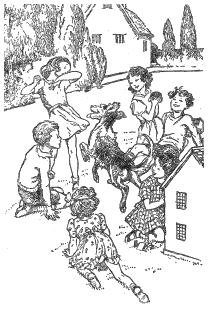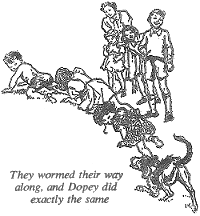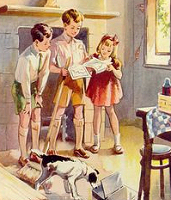
Those Dreadful Children
Review by Laura Canning (July 16, 2006)
Like a lot of Enid Blyton's works, this book is intended to be not just a story but a treatise on morals, manners and doing the 'right thing'. This is fine in itself—the Famous Five, Malory Towers, St Clare's and the like all operate on the basis of their characters being decent, upright sorts—but Those Dreadful Children is one of the few Blyton books to emphasise religion as the way to do this. Pour moi, this marred the book a little. Still, only a little—this is still a Jolly Good Read.

Thus the scene is set. Impatient to see the Taggertys and explore the garden, John and Margery go over each evening, tut-tutting at the overgrown garden and always being careful to keep their clothes clean. But alas! On the third evening, they are sheltering under a tree from the rain when the Taggerty children—ten year old Pat, eight year old Maureen and five year old Biddy—arrive and catch them. There is a nice bit of 'ragging', where any right-minded reader will heartily cheer on the Taggertys, before John and Margery escape back home, horrified at the way 'those dreadful children' behave.
The really nice thing about this book is the way both families are portrayed as 'dreadful children'. In Blyton-land, noisy, rough children with bad manners are likely to be labelled dreadful, but she does an excellent job of showing how prim and proper the Carlton family is in comparison. Mother won't let them play with anyone apart from 'those stuck-up Fitzgeralds', she won't allow pets because the house has to be spotless at all times, Annette is a spoilt cry baby and a tell tale... at this stage of the story all reader sympathies are firmly with the Taggertys. There is a great scene where Pat meets Annette for the first time, and not only doesn't give her sympathy when she grazes her knee, but calls her a 'funny cry baby' with her mouth wide open for the flies to get in. 'Maureen, come and see,' he says to his sister, but Annette has fled up the garden, 'screaming in anger'. Heh.

Even Mr Carlton can see the dreadfulness of his own family, although he can perhaps be tarred with the same brush as he tactlessly talks about it at dinner in front of the three children: John isn't a 'real boy' because he won't climb trees and get his clothes dirty, and Margery and Annette are scared of everything. 'Mother,' he says (!), 'it's time we did something about these children of ours. They're good and well-behaved, and truthful, and nice-mannered, but are they proper children? No, they're not!' Personally if I was Mr Carlton I'd be questioning whether they were in fact the children of the milkman, but no doubt that's a whole other genre...
And alas for all six children—Mr Taggerty and Mr Carlton are friends from school, so the Taggertys have to be invited to tea! And the Carltons in turn... predictably enough, the children do end up becoming friends, with the Carlton children in particular getting the 'corners' rubbed off them. Even Mrs Carlton deigns to like jolly Mrs Taggerty! The Carltons are not nearly so prim and proper, Mother is not as judgemental, and Annette decides she worships Pat so puts up with being teased and doesn't run home crying any more. And Mother even lets Annette have a kitten for her birthday!
But then Blyton turns the story on its head. Yes, the Carltons were annoyingly good and the Taggertys amusingly lively in comparison, but the Taggerty children also have some very bad habits that even I was shocked at! They won't run errands for their mother, they won't help with baby Michael, they run about noisily with their dog Dopey when they know Michael is sleeping, they cheat at school, tell lies and don't mind if they worry their mother by pretending to be ill so they can get out of school... Mrs Taggerty despairs of them, but doesn't know what to do. She was ill for so long, she tells Mrs Carlton, and the children just ran wild.
Unfortunately Blyton's way of making the Taggertys decent is to hit 'em with religion. Maureen and then Biddy start going to Sunday school with the Carltons, although Pat, quite sensibly, stays away. He does manage to own up to a neighbour for breaking her cucumber frame with a cricket ball (why is it always a cucumber frame in kids' books?) after John tells him it is cowardly not to, but by and large he does his own thing as usual. Maureen tells Annette she should pray for God to find her lost kitten, who promptly turns up stranded up the nearest tree. But even Pat starts to become a proper Christian because of the day 'When Dinner Was Late'.

Mrs Taggerty has to go to the grocers' when all three of her selfish brats refuse to go for her, even though she is ill. Calamity strikes—she is hit by a car and is in hospital, it is not known if she will live. Pat, who had worried his parents by bringing home a letter threatening to expel him from school, is badly affected, and makes a 'solemn promise to God' that he will be kind, and decent, and truthful, and helpful, from now on. That's the book pretty much wrapped up, with a note of comedy to finish when both families label their Christmas presents to each other with 'Happy Christmas to THOSE DREADFUL CHILDREN!'
Despite a slightly contrived (though genuinely lump-in-throat touching) finish, this is a really excellent read. The way Blyton switches reader sympathies between the Carltons and the Taggertys, showing that both have their good and bad sides, is very well done, and there are some nicely written pieces too. Annette 'screaming in anger' is great, as are the descriptions of the daft dog Dopey, while in the first chapter when John and Margery look through the scullery window of the empty Taggerty house, they see a dripping tap which is described as 'the evening sun caught the drips and made them shine'. No need for this description, which makes it all the nicer... The book also has quite a mature tone in places compared to more standard Blyton fare, although the ages of the six children seem to indicate this book is aimed at the same age group as the Secret Seven series. It is a one-off of the same quality as The Put Em Rights and The Six Bad Boys, two more excellent Blytons that seem to be written in a slightly more literary and mature style. I'm still hunting the charity shops to reread those ones, so watch this space...


